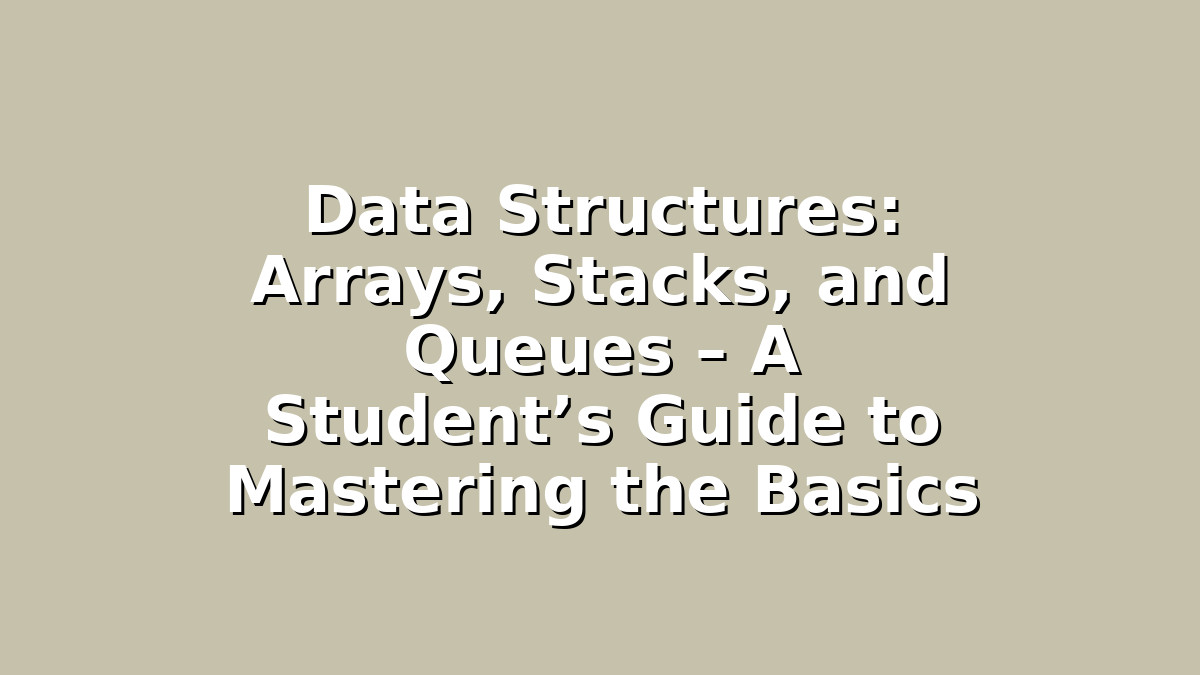When preparing for exams in computer science or software engineering, understanding fundamental data structures is crucial. Arrays, stacks, and queues form the backbone of many algorithms and programs. Mastering these concepts not only helps you ace tests but also builds a strong foundation for advanced topics. In this article, we will explore each of these data structures in detail, providing clear explanations, practical examples, and effective study tips to help you succeed.
Understanding Arrays: The Building Blocks of Data Storage
An array is one of the simplest and most widely used data structures. Think of it as a collection of elements stored in contiguous memory locations. Each element can be accessed directly using its index, which makes arrays incredibly efficient for certain operations.
Key Characteristics of Arrays:
– Fixed size (in most languages).
– Elements are stored sequentially.
– Direct access to elements using an index.
– Can store elements of the same data type.
Example:
Imagine an array of integers representing student scores: [85, 90, 78, 92, 88]. Accessing the third score is straightforward—just use the index 2 (since arrays are zero-indexed) to retrieve 78.
Study Tips for Arrays:
– Visualize the layout: Draw diagrams to represent the array and its indices. This helps you understand how elements are arranged and accessed.
– Practice indexing: Work on problems that require accessing, updating, or iterating through arrays to strengthen your familiarity.
– Understand time complexity: Memorize that accessing an element by index is O(1), but inserting or deleting elements can be costly since it may require shifting elements.
– Work on coding problems: Use platforms like LeetCode or HackerRank to solve array-based questions. This hands-on practice is invaluable.
Stacks: The Last In, First Out (LIFO) Structure
Stacks are data structures that follow the Last In, First Out principle. Imagine a stack of plates: you add (push) a plate on top and remove (pop) the top plate first. This simple concept is powerful and widely used in function call management, expression evaluation, and backtracking algorithms.
Key Characteristics of Stacks:
– Supports two main operations: push (add an element) and pop (remove an element).
– Only the top element is accessible at any time.
– Can be implemented using arrays or linked lists.
– Often includes a peek operation to view the top element without removing it.
Example:
Consider a stack of browser history URLs. When you visit a new page, it is pushed onto the stack. Pressing the back button pops the last visited page from the stack.
Study Tips for Stacks:
– Master the push/pop operations: Write simple codes implementing these operations and trace them step-by-step with pen and paper.
– Use real-world analogies: Relate stacks to everyday objects like plates, books, or undo features in text editors to internalize the concept.
– Visualize the stack growth: Draw the stack’s state after each operation. This helps in understanding how elements flow in and out.
– Solve common problems: Practice problems involving balanced parentheses, reverse strings, and function call stacks to reinforce your understanding.
– Trace recursive calls: Many recursion problems can be understood better by simulating the call stack manually.
Queues: The First In, First Out (FIFO) Structure
Queues operate on a First In, First Out basis, similar to a line of people waiting at a ticket counter. The first person to enter the queue is the first to be served. This structure is essential in scenarios like scheduling tasks, handling requests, and breadth-first searches in graphs.
Key Characteristics of Queues:
– Supports two main operations: enqueue (add an element at the rear) and dequeue (remove an element from the front).
– Only the front and rear elements are accessible.
– Can be implemented using arrays, linked lists, or circular arrays.
– Variations include circular queues, priority queues, and double-ended queues (deques).
Example:
Imagine a queue of print jobs in a printer spooler. Jobs are processed in the order they arrive, ensuring fairness.
Study Tips for Queues:
– Understand enqueue and dequeue: Practice coding these operations and tracing the queue’s state after each step.
– Visualize as a line: Drawing the queue helps you track the front and rear pointers and understand how elements move.
– Explore variations: Get familiar with circular queues and priority queues as they often appear in exams and interviews.
– Solve real-world problems: Practice issues like implementing a producer-consumer model or simulating a ticketing system.
– Time complexity awareness: Know that enqueue and dequeue operations are typically O(1), but improper implementation might cause inefficiencies.
Combining Study Strategies to Master Data Structures
Learning arrays, stacks, and queues in isolation is helpful, but integrating your knowledge is key to exam success. Here are some additional study techniques:
– Create flashcards: Summarize operations, time complexities, and use cases on flashcards for quick revision.
– Teach someone else: Explaining these concepts to a peer or even to yourself aloud helps reinforce understanding.
– Use visual aids: Interactive tools and animations can make abstract concepts more concrete.
– Work on mini-projects: Build small programs like a browser history manager (stack), task scheduler (queue), or a simple inventory list (array).
– Review and repeat: Schedule regular revision sessions to ensure long-term retention.
Conclusion
Arrays, stacks, and queues are fundamental data structures every computer science student must master. They form the groundwork for more complex structures and algorithms. By visualizing their operations, practicing coding exercises, and relating concepts to real-life examples, you can confidently approach your exams and projects. Remember, consistent practice and a proactive learning approach are your best allies in mastering data structures. Stay curious, keep coding, and don’t hesitate to seek help when needed. Success is within your reach!

Responses